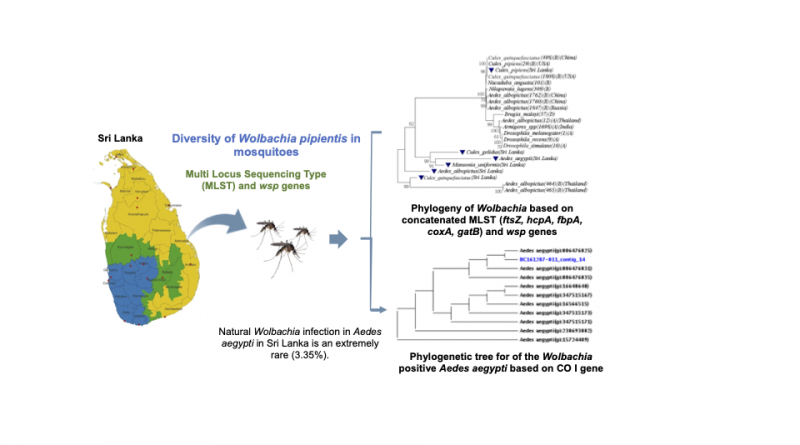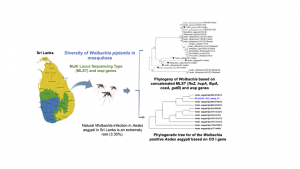Diversity of Wolbachia infections in Sri Lankan mosquitoes with a new record of Wolbachia Supergroup B infecting Aedes aegypti vector populations
Diversity of Wolbachia infections in Sri Lankan mosquitoes with a new record of Wolbachia Supergroup B infecting Aedes aegypti vector populations
ความหลากหลายของการติดเชื้อ Wolbachia ในยุงศรีลังกาและการพบ Wolbachia Supergroup B ที่ติดเชื้อในประชากรของ Aedes aegypti
Wolbachia bacteria are common endosymbionts of insects and have recently been applied for controlling arboviral vectors, especially Aedes aegypti mosquito populations. However, several medically important mosquito species in Sri Lanka were present with limited information for the Wolbachia infection status. Therefore, the screening of Wolbachia in indigenous mosquitoes is required prior to a successful application of Wolbachia-based vector control strategy. In this study, screening of 78 mosquito species collected from various parts of the country revealed that 13 species were positive for Wolbachia infection, giving ~ 17% infection frequency of Wolbachia among the Sri Lankan mosquitoes. Twelve Wolbachia-positive mosquito species were selected for downstream Wolbachia strain genotyping using Multi Locus Sequencing Type (MLST), wsp gene, and 16S rRNA gene-based approaches. Results showed that these Wolbachia strains clustered together with the present Wolbachia phylogeny of world mosquito populations with some variations. Almost 90% of the mosquito populations were infected with supergroup B while the remaining were infected with supergroup A. A new record of Wolbachia supergroup B infection in Ae. aegypti, the main vectors of dengue, was highlighted. This finding was further confirmed by real-time qPCR, revealing Wolbachia density variations between Ae. aegypti and Ae. albopictus (p = 0.001), and between males and females (p < 0.05). The evidence of natural Wolbachia infections in Ae. aegypti populations in Sri Lanka is an extremely rare incident that has the potential to be used for arboviral vector control.
แบคทีเรียโวลบาเกีย (Wolbachia) เป็นแบคทีเรียที่อาศัยอยู่ในแมลงที่พบได้ทั่วไปและถูกนำมาใช้ในการควบคุมแมลงที่เป็นพาหะนำโรคจากไวรัส โดยเฉพาะยุงลายบ้าน (Aedes aegypti) อย่างไรก็ดีข้อมูลการติดเชื้อแบคทีเรียโวลบาเกียของยุงที่มีความสำคัญในทางการแพทย์ในประเทศศรีลังกานั้นยังมีน้อย ดังนั้นการวิเคราะห์แบคทีเรียโวลบาเกียในยุงพื้นเมืองจึงเป็นสิ่งจำเป็นก่อนที่จะนำไปประยุกต์ใช้ในการควบคุมยุงด้วยแบคทีเรียโวลบาเกีย งานวิจัยนี้ได้วิเคราะห์ยุง 78 สปีชีส์ที่เก็บมาจากภูมิภาคต่างๆในประเทศศรีลังกา และพบว่ามียุงที่ติดเชื้อแบคทีเรียโวลบาเกีย 13 สปีชีส์ ซึ่งคิดเป็นความถี่ของการติดเชื้อแบคทีเรียโวลบาเกียประมาณ 17% ของยุงประเทศศรีลังกา ซึ่งได้นำยุงที่ติดเชื้อแบคทีเรียโวลบาเกีย 12 สปีชีส์มาวิเคราะห์ความแตกต่างทางพันธุกรรมโดยใช้ Multi Locus Sequencing Type (MLST), ยีนwsp และยีน16S rRNA ผลการทดลองพบว่าสายพันธุ์โวลบาเกียเหล่านี้อยู่ในกลุ่มลักษณะเดียวกับยุงในพื้นที่อื่นบนโลกโดยมีความแตกต่างเล็กน้อย ประชากรยุงเกือบ 90% ติดเชื้อแบคทีเรียโวลบาเกียสายพันธุ์ซูเปอร์กรุ๊ปบี ในขณะที่เหลือติดเชื้อสายพันธุ์ซูเปอร์กรุ๊ปเอ และพบข้อมูลใหม่ว่ายุงลายบ้านที่เป็นพาหะหลักของไข้เลือดออกติดเชื้อแบคทีเรียโวลบาเกียสายพันธุ์ซูเปอร์กรุ๊ปบี ซึ่งเมื่อวิเคราะห์ด้วยวิธี real-time qPCR พบว่าความหนาแน่นของแบคทีเรียโวลบาเกียระหว่างยุงลายบ้านกับยุงลายสวน (p = 0.001) และระหว่างยุงเพศผู้กับยุงเพศเมีย (p < 0.05) มีความแตกต่างกัน และพบหลักฐานว่ายุงลายบ้านที่ติดเชื้อแบคทีเรียโวลบาเกียในประเทศศรีลังกามีจำนวนน้อยมาก จึงสามารถนำแบคทีเรียมาใช้ควบคุมเชื้อไวรัสที่นำโดยแมลงพาหะได้
สนับสนุน SDGs เป้าหมายที่ 3 สร้างหลักประกันว่าคนมีชีวิตที่มีสุขภาพดีและส่งเสริมสวัสดิภาพสำหรับทุกคนในทุกวัย
3.3 ยุติการแพร่กระจายของเอดส์ วัณโรค มาลาเรีย และโรคเขตร้อนที่ถูกละเลย และต่อสู้กับโรคตับอักเสบ
โรคติดต่อทางน้ำ และโรคติดต่ออื่นๆ ภายในปี 2573


